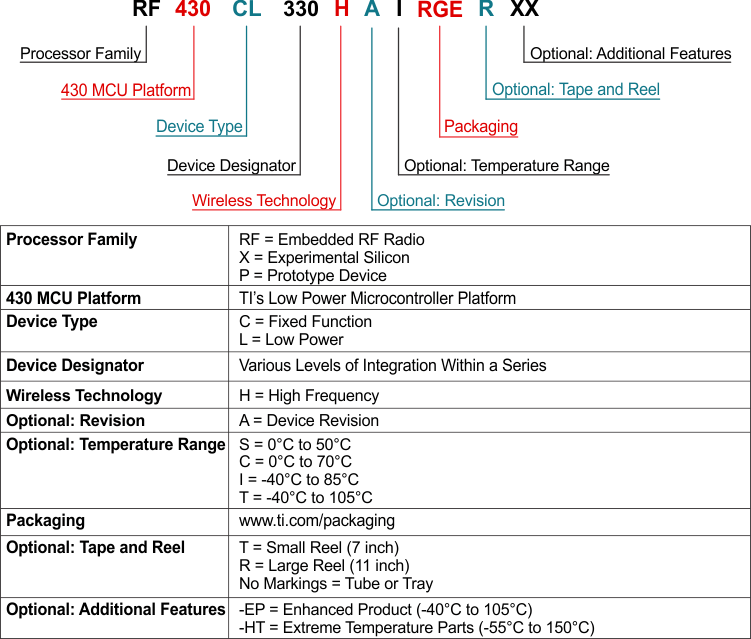SLAS916C November 2012 – November 2014 RF430CL330H
PRODUCTION DATA.
- 1Device Overview
- 2Revision History
- 3Terminal Configuration and Functions
-
4Specifications
- 4.1 Absolute Maximum Ratings
- 4.2 Handling Ratings
- 4.3 Recommended Operating Conditions
- 4.4 Recommended Operating Conditions, Resonant Circuit
- 4.5 Supply Currents
- 4.6 Digital Inputs
- 4.7 Digital Outputs
- 4.8 Thermal Characteristics
- 4.9 Serial Communication Protocol Timings
- 4.10 I2C Interface
- 4.11 SPI Interface
- 4.12 RF143B, Recommended Operating Conditions
- 4.13 RF143B, ISO14443B ASK Demodulator
- 4.14 RF143B, ISO14443B-Compliant Load Modulator
- 4.15 RF143B, Power Supply
- 5Detailed Description
- 6Device and Documentation Support
- 7Mechanical Packaging and Orderable Information
パッケージ・オプション
メカニカル・データ(パッケージ|ピン)
サーマルパッド・メカニカル・データ
発注情報
6 Device and Documentation Support
6.1 Device Support
6.1.1 Development Support
6.1.1.1 Getting Started and Next Steps
For more information on the RF430 family of devices and the tools and software that are available to help with your development, visit the Tools & Software for NFC / RFID page.
The Dynamic Near Field Communication (NFC) Type 4B Tag design (TIDM-DYNAMICNFCTAG) outlines the required components, layout considerations, and provides firmware examples to implement NFC into applications such as Bluetooth/Wi-Fi pairing, equipment configuration and diagnostics, or as a general purpose NFC data interface. The documentation, hardware, and example code provided allows the designer to quickly implement NFC functionality with an MSP430™ MCU or other MCU of choice.
6.1.2 Device and Development Tool Nomenclature
To designate the stages in the product development cycle, TI assigns prefixes to the part numbers of all RF430 MCU devices and support tools. Each commercial family member has one of three prefixes: RF, P, or X (for example, RF430CL330H). Texas Instruments recommends two of three possible prefix designators for its support tools: RF and X. These prefixes represent evolutionary stages of product development from engineering prototypes (with X for devices and tools) through fully qualified production devices and tools (with RF for devices tools).
Device development evolutionary flow:
X – Experimental device that is not necessarily representative of the final device's electrical specifications
P – Final silicon die that conforms to the device's electrical specifications but has not completed quality and reliability verification
RF – Fully qualified production device
Support tool development evolutionary flow:
X – Development-support product that has not yet completed Texas Instruments internal qualification testing.
RF – Fully-qualified development-support product
X and P devices and X development-support tools are shipped against the following disclaimer:
"Developmental product is intended for internal evaluation purposes."
RF devices and RF development-support tools have been characterized fully, and the quality and reliability of the device have been demonstrated fully. TI's standard warranty applies.
Predictions show that prototype devices (X and P) have a greater failure rate than the standard production devices. Texas Instruments recommends that these devices not be used in any production system because their expected end-use failure rate still is undefined. Only qualified production devices are to be used.
TI device nomenclature also includes a suffix with the device family name. This suffix indicates the package type (for example, RGE) and temperature range (for example, T). Figure 6-1 provides a legend for reading the complete device name for any family member.
 Figure 6-1 Device Nomenclature
Figure 6-1 Device Nomenclature
6.2 Documentation Support
The following documents describe the RF430CL330H device. Copies of these documents are available on the Internet at www.ti.com.
-
SLAZ540RF430CL330H Device Erratasheet. Describes the known exceptions to the functional specifications for the RF430CL330H device.
-
SLOA187Automating Bluetooth(R) Pairing With Near-Field Communications (NFC). This collaborative document is a follow up to a previously released specification by the NFC Forum titled NFC Forum Connection Handover Specification, which began to define the structure and sequence of interactions that enable two NFC-enabled devices to establish a connection using other wireless communication technologies. This application report explains how to implement the NFC Forum/Bluetooth SIG specification in an embedded application using the RF430CL330H dynamic NFC transponder.
6.3 Community Resources
The following links connect to TI community resources. Linked contents are provided "AS IS" by the respective contributors. They do not constitute TI specifications and do not necessarily reflect TI's views; see TI's Terms of Use.
TI's Engineer-to-Engineer (E2E) Community. Created to foster collaboration among engineers. At e2e.ti.com, you can ask questions, share knowledge, explore ideas and help solve problems with fellow engineers.
6.4 Trademarks
MSP430, E2E are trademarks of Texas Instruments.
Bluetooth is a registered trademark of Bluetooth SIG, Inc.
Wi-Fi is a registered trademark of Wi-Fi Alliance.
All other trademarks are the property of their respective owners.
6.5 Electrostatic Discharge Caution

This integrated circuit can be damaged by ESD. Texas Instruments recommends that all integrated circuits be handled with appropriate precautions. Failure to observe proper handling and installation procedures can cause damage.
ESD damage can range from subtle performance degradation to complete device failure. Precision integrated circuits may be more susceptible to damage because very small parametric changes could cause the device not to meet its published specifications.
6.6 Glossary
SLYZ022 — TI Glossary.
This glossary lists and explains terms, acronyms, and definitions.